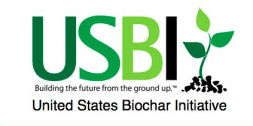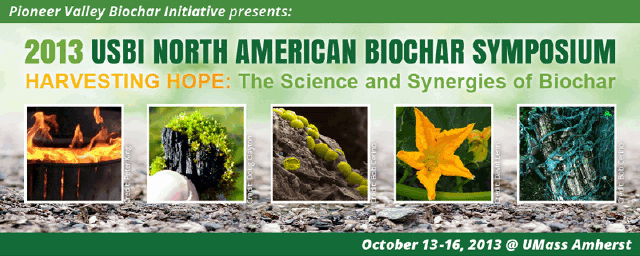Benefits & Uses of Biochar
Nutrient Retention & Composting
Streaming Media
Bob Cirino presentation
B&U Session 8 - Mahoney.pdf (3547 kB)
Ryan Mahoney presentation
Location
CC 101
Start Date
16-10-2013 1:30 PM
End Date
16-10-2013 2:50 PM
Session Description
Maturation of biochar in a thermophilic composting process – B. Cirino, University of Delaware
Pretreatment of biochar prior to soil application has a profound effect on its performance as an amendment. The incorrect, or nonexistent, pretreatment of biochar prior to application is an unfortunate shortcoming found both in the scientific and industrial realms. When biochar is subjected to a thermophilic composting system, many properties undergo change including cation exchange capacity, particle surface area, extractable nutrients, microbial community composition and abundance, and oxidation of biochar surfaces. By sampling particles periodically over the course of a composting process, we are able to provide a time-based demonstration that composting biochar yields a unique product more suitable for plant growing systems than its untreated counterpart. In pot trials amended with samples from each time period, we are able to examine plant response (including biomass, nutrient uptake, and root architecture) as well as microbial community abundance and composition with respect to maturation time.
My study looks at composting biochar as a process to create a superior product. Over the course of a 16 week composting period, chemical, physical, and biological changes are documented in attempt to characterize the maturation process of the particles. The effects of the biochar compost at each time point in the process will be examined for plant performance and soil microbial communities.
Nitrogen Retention During Composting with Biochar – R. Hestrin, Cornell University
Compost is a valuable soil amendment that can be produced locally and used by smallholders worldwide. Compost can confer many benefits to agricultural systems, but nitrogen (N) loss during composting can be substantial, resulting in air pollution and reduced nutrient value of the compost. Previous studies have shown that biochar additions to compost influence N cycling and reduce gaseous N loss from compost. However, little is known about biochar-compost interactions and the mechanisms responsible for improved N retention. We investigated the effect of biochar characteristics on its capacity to reduce ammonia (NH3) loss from compost. Our hypothesis was that biochar’s capacity to reduce NH3 volatilization was largely dependent on the acidic functionality of biochar’s surfaces. A range of biochars with varying acidic functionality were produced. The sorption capacity of each biochar was evaluated with adsorption isotherms. Subsequently, the biochars were added to batches of compost feedstock and placed in bioreactors. The different compost-biochar mixtures were monitored for moisture, temperature, pH, gas emission, mass loss, and C/N content. The results from this experiment can be used to optimize biochar characteristics for compost production and improve N use efficiency in agricultural systems. By using biochar to improve N retention in compost, farmers can improve N delivery to crops without increasing their dependence on synthetic fertilizers.
Retention and plant bioavailability of urine derived nutrients by biochar– J. Kearns, University of Colorado
http://www.youtube.com/watch?v=xxsb_MSpeRg
Biochars produced by “low--‐tech” methods (e.g. top lit up--‐draft (TLUD) cookstoves and drum ovens, Externally heated retorts) from arrange of feedstocks (e.g. biomass fuel pellets, rice husks, woody brush, Fecal sludge) were used in batch tests to sorb key nutrient components of real and synthetic human urine. Sorption of potassium, phosphorus, and multiple species of nitrogen (such as ureaandammonia) using powdered biochar in well mixed batch reactors and continuous--‐flow columns were used to validate uptake capacities. Bioavailability of sorbed N, P, and K were then determined by standard methods. Odor control was also evaluated. This work displays the potential of biochars to be ‘pre--‐loaded’ with nutrients before application to soil, enhancing the biochars value and simplifying a farmer’s application procedure for crop enhancement products. Additionally it shows the potential for a more efficient sourcing of nitrogen for agricultural purposes. Nitrogen is abundant in human/animal urine, and is commonly labeled as a contaminant for removal in traditional wastewater processes due to it causing harmful algal blooms in receiving waters. This work shows the possibility of more efficiently using this nitrogen, typically labeled a waste, and offsetting the need for industrial produced nitrogen salts. Biochar infused with adsorbed nitrogen can also have beneficial effects when combined with composts.
Nutrient Retention & Composting
CC 101
Maturation of biochar in a thermophilic composting process – B. Cirino, University of Delaware
Pretreatment of biochar prior to soil application has a profound effect on its performance as an amendment. The incorrect, or nonexistent, pretreatment of biochar prior to application is an unfortunate shortcoming found both in the scientific and industrial realms. When biochar is subjected to a thermophilic composting system, many properties undergo change including cation exchange capacity, particle surface area, extractable nutrients, microbial community composition and abundance, and oxidation of biochar surfaces. By sampling particles periodically over the course of a composting process, we are able to provide a time-based demonstration that composting biochar yields a unique product more suitable for plant growing systems than its untreated counterpart. In pot trials amended with samples from each time period, we are able to examine plant response (including biomass, nutrient uptake, and root architecture) as well as microbial community abundance and composition with respect to maturation time.
My study looks at composting biochar as a process to create a superior product. Over the course of a 16 week composting period, chemical, physical, and biological changes are documented in attempt to characterize the maturation process of the particles. The effects of the biochar compost at each time point in the process will be examined for plant performance and soil microbial communities.
Nitrogen Retention During Composting with Biochar – R. Hestrin, Cornell University
Compost is a valuable soil amendment that can be produced locally and used by smallholders worldwide. Compost can confer many benefits to agricultural systems, but nitrogen (N) loss during composting can be substantial, resulting in air pollution and reduced nutrient value of the compost. Previous studies have shown that biochar additions to compost influence N cycling and reduce gaseous N loss from compost. However, little is known about biochar-compost interactions and the mechanisms responsible for improved N retention. We investigated the effect of biochar characteristics on its capacity to reduce ammonia (NH3) loss from compost. Our hypothesis was that biochar’s capacity to reduce NH3 volatilization was largely dependent on the acidic functionality of biochar’s surfaces. A range of biochars with varying acidic functionality were produced. The sorption capacity of each biochar was evaluated with adsorption isotherms. Subsequently, the biochars were added to batches of compost feedstock and placed in bioreactors. The different compost-biochar mixtures were monitored for moisture, temperature, pH, gas emission, mass loss, and C/N content. The results from this experiment can be used to optimize biochar characteristics for compost production and improve N use efficiency in agricultural systems. By using biochar to improve N retention in compost, farmers can improve N delivery to crops without increasing their dependence on synthetic fertilizers.
Retention and plant bioavailability of urine derived nutrients by biochar– J. Kearns, University of Colorado
http://www.youtube.com/watch?v=xxsb_MSpeRg
Biochars produced by “low--‐tech” methods (e.g. top lit up--‐draft (TLUD) cookstoves and drum ovens, Externally heated retorts) from arrange of feedstocks (e.g. biomass fuel pellets, rice husks, woody brush, Fecal sludge) were used in batch tests to sorb key nutrient components of real and synthetic human urine. Sorption of potassium, phosphorus, and multiple species of nitrogen (such as ureaandammonia) using powdered biochar in well mixed batch reactors and continuous--‐flow columns were used to validate uptake capacities. Bioavailability of sorbed N, P, and K were then determined by standard methods. Odor control was also evaluated. This work displays the potential of biochars to be ‘pre--‐loaded’ with nutrients before application to soil, enhancing the biochars value and simplifying a farmer’s application procedure for crop enhancement products. Additionally it shows the potential for a more efficient sourcing of nitrogen for agricultural purposes. Nitrogen is abundant in human/animal urine, and is commonly labeled as a contaminant for removal in traditional wastewater processes due to it causing harmful algal blooms in receiving waters. This work shows the possibility of more efficiently using this nitrogen, typically labeled a waste, and offsetting the need for industrial produced nitrogen salts. Biochar infused with adsorbed nitrogen can also have beneficial effects when combined with composts.



Bio and Photo
Bob Cirino, also known as “Biochar Bob”, the internet personality that communicated the biochar universe to a general audience, researches biochar dynamics in living systems and intra-cellular calcium signalling at the University of Delaware.
Ryan B. Mahoney holds a B.S. in Civil Engineering from Northeastern University and an M.S. in Environmental Engineering from the University of Colorado Boulder (CU). He is currently a researcher on the Sol-Char Toilet project at CU where he investigates biochar and its potential role in the sanitation and agricultural sectors. He has been working in Dr. Scott Summers Lab for over 2 years, studying appropriate methods of biochar generation and evaluating adsorption and surface reactions on the media. Mr. Mahoney received the Mortenson Center’s Certificate in Engineering for Developing Communities, completing a field practicum evaluating rural water and sanitation infrastructure projects in the Amazon region of Peru. He also has significant international water and sanitation experience with the humanitarian non-profit Engineers Without Borders USA both at CU and NU. As Project Manager he led various trips implementing a gravity fed water systems in Peru and Honduras, as well as monitoring and evaluating of previous sanitation projects. During his time at NU, he gained valuable experience as Vice President of the EWB-NU and during three 6 month periods of full time employment (‘coops’) working for civil and environmental engineering firms such as CDM Smith and Kleinfelder.